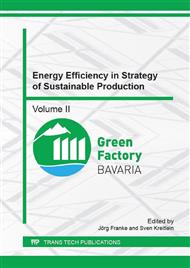p.181
p.188
p.195
p.201
p.209
p.217
p.224
p.231
p.238
Investigation and Prognosis of Waste Heat Occurrence during the Extrusion Process of Tubular Profiles
Abstract:
Extrusion is a fundamental procedure of polymer processing and is used to produce tubular profiles, foils, cable coatings, etc. Rising energy prices increase the pressure for extruder manufacturers and operators to cut costs. Nowadays, extruder manufacturers are forced to develop more energy-efficient extruders. One possibility to reach that goal is to reuse the occurring waste heat during the extrusion process. Operators could use the waste heat within their own company to reduce their primary energy costs. The prediction of energy consumption and usage of waste heat for new extrusion lines as well as existing extrusion lines with new products within the planning stage is very important. Additionally the energy recovery for new extrusion lines has to be projected within planning stage. The research approach is to enable the construction of energy recovery for future production based on theoretical view and the energy monitoring of real extrusion lines. Therefor a program was developed to forecast the amount of waste heat. The energy monitoring included the energy consumption of the main consumers and the waste heat amount of cooling chambers and barrel cooling for three different single grooved barrel extruders. The energy monitoring results show that some of the temperature of the cooling chambers qualifies for reutilization. The barrel cooling waste heat can be fully reused. The program calculates the cooling of the tubular profile with finite element difference wherein the heat transfer is calculated in the radial direction. The thermal state of the tubular profile can be simulated at every position within the extrusion line. Furthermore the thermal output into the coolant can be calculated. The calculated and collected data are satisfactory more often than not. Based on the energy monitoring results concepts for the usage of waste heat were elaborated. Thereupon measures for the usage of waste heat were implemented and validated.
Info:
Periodical:
Pages:
209-216
Citation:
Online since:
November 2016
Authors:
Keywords:
Price:
Сopyright:
© 2017 Trans Tech Publications Ltd. All Rights Reserved
Share:
Citation:


